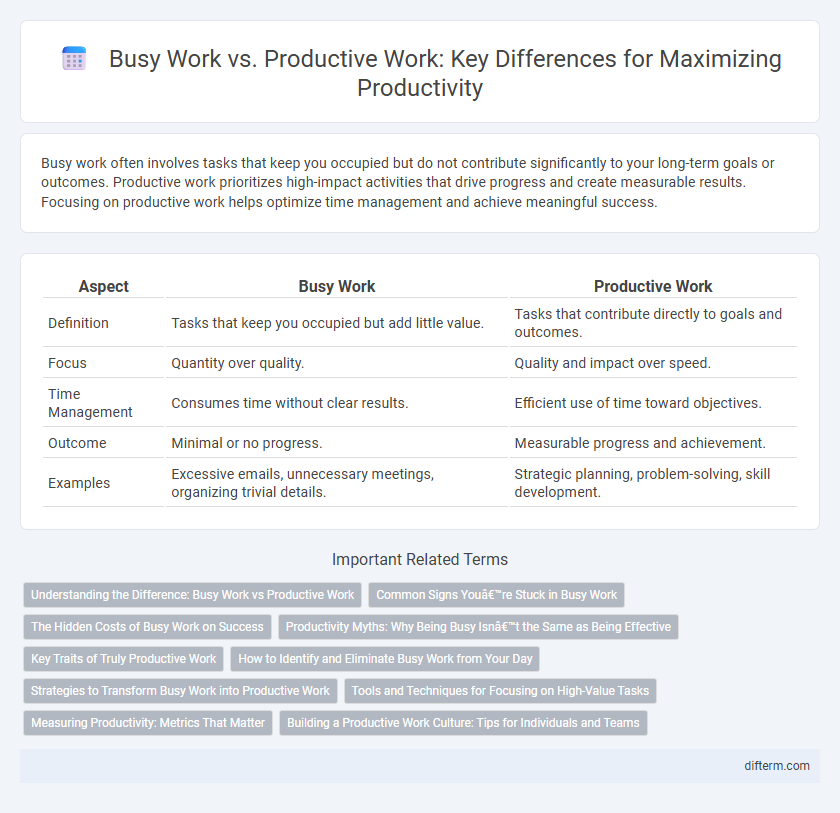Busy work often involves tasks that keep you occupied but do not contribute significantly to your long-term goals or outcomes. Productive work prioritizes high-impact activities that drive progress and create measurable results. Focusing on productive work helps optimize time management and achieve meaningful success.
Table of Comparison
| Aspect | Busy Work | Productive Work |
|---|---|---|
| Definition | Tasks that keep you occupied but add little value. | Tasks that contribute directly to goals and outcomes. |
| Focus | Quantity over quality. | Quality and impact over speed. |
| Time Management | Consumes time without clear results. | Efficient use of time toward objectives. |
| Outcome | Minimal or no progress. | Measurable progress and achievement. |
| Examples | Excessive emails, unnecessary meetings, organizing trivial details. | Strategic planning, problem-solving, skill development. |
Understanding the Difference: Busy Work vs Productive Work
Busy work involves tasks that keep you occupied but often lack meaningful progress or measurable outcomes, consuming time without driving significant results. Productive work focuses on high-impact activities aligned with clear goals, maximizing efficiency and value creation. Recognizing the difference enables prioritizing tasks that contribute directly to objectives, avoiding time-wasting efforts that hinder overall productivity.
Common Signs You’re Stuck in Busy Work
Struggling to make meaningful progress despite long hours often indicates busy work rather than productive work. Common signs include constant task-switching without completing priorities, frequent meetings with little actionable outcome, and an overflowing to-do list that never seems to shrink. Recognizing these patterns helps shift focus to high-impact activities that drive real results and boost overall productivity.
The Hidden Costs of Busy Work on Success
Busy work consumes valuable time and energy without contributing to meaningful progress, leading to decreased overall productivity and delayed goal achievement. The hidden costs of busy work include increased stress levels, reduced focus on high-impact tasks, and burnout, which undermine long-term success. Prioritizing productive work involves identifying tasks with clear outcomes and measurable impact, ensuring efforts drive real results rather than mere activity.
Productivity Myths: Why Being Busy Isn’t the Same as Being Effective
Many mistakenly equate busy work with productivity, but true productivity hinges on achieving meaningful outcomes rather than simply filling time with tasks. Research shows that multitasking and constant busyness can reduce focus and efficiency, leading to lower quality results. Prioritizing goal-oriented work and time management strategies enhances productivity by aligning efforts with impactful objectives.
Key Traits of Truly Productive Work
Truly productive work is characterized by clear goals, measurable outcomes, and a focus on high-impact tasks that drive progress toward strategic objectives. It involves prioritizing activities that contribute directly to meaningful results rather than merely filling time with busy work or low-value tasks. Emphasizing deep focus, effective time management, and outcome-oriented approaches differentiates productive work from superficial busyness.
How to Identify and Eliminate Busy Work from Your Day
Identifying busy work involves analyzing tasks that consume time without significantly advancing key goals, such as excessive email checking or attending unnecessary meetings. Tracking daily activities using time audits and prioritizing tasks based on their impact on productivity helps distinguish essential work from distractions. Eliminating busy work requires setting clear boundaries, automating repetitive processes, and delegating low-value tasks to focus on high-priority responsibilities that drive meaningful progress.
Strategies to Transform Busy Work into Productive Work
Identifying and eliminating tasks that offer minimal value is essential for transforming busy work into productive work. Prioritizing activities aligned with key goals through time-blocking and the Eisenhower Matrix enhances focus and efficiency. Automating repetitive processes and delegating non-core tasks free up time for strategic initiatives, significantly boosting overall productivity.
Tools and Techniques for Focusing on High-Value Tasks
Utilizing task management tools like Trello and time-blocking techniques helps prioritize high-value tasks, reducing time spent on busy work. Techniques such as the Pomodoro method enhance focus and minimize distractions during critical activities. Automation tools like Zapier streamline repetitive tasks, allowing more energy to be directed toward impactful work.
Measuring Productivity: Metrics That Matter
Effective measurement of productivity hinges on distinguishing between busy work and productive work, emphasizing key performance indicators such as output quality, task completion rates, and time utilization efficiency. Metrics like the ratio of meaningful deliverables to total tasks and the impact of completed work on organizational goals provide a clearer picture of true productivity. Tracking these metrics enables teams to prioritize high-value activities that drive progress, rather than simply increasing activity levels.
Building a Productive Work Culture: Tips for Individuals and Teams
Building a productive work culture requires distinguishing between busy work and high-impact tasks that drive results. Encourage setting clear goals, prioritizing meaningful projects, and fostering open communication to minimize distractions and enhance focus. Empowering teams with time management tools and continual feedback creates an environment where efficiency and innovation thrive.
Busy work vs Productive work Infographic

 difterm.com
difterm.com